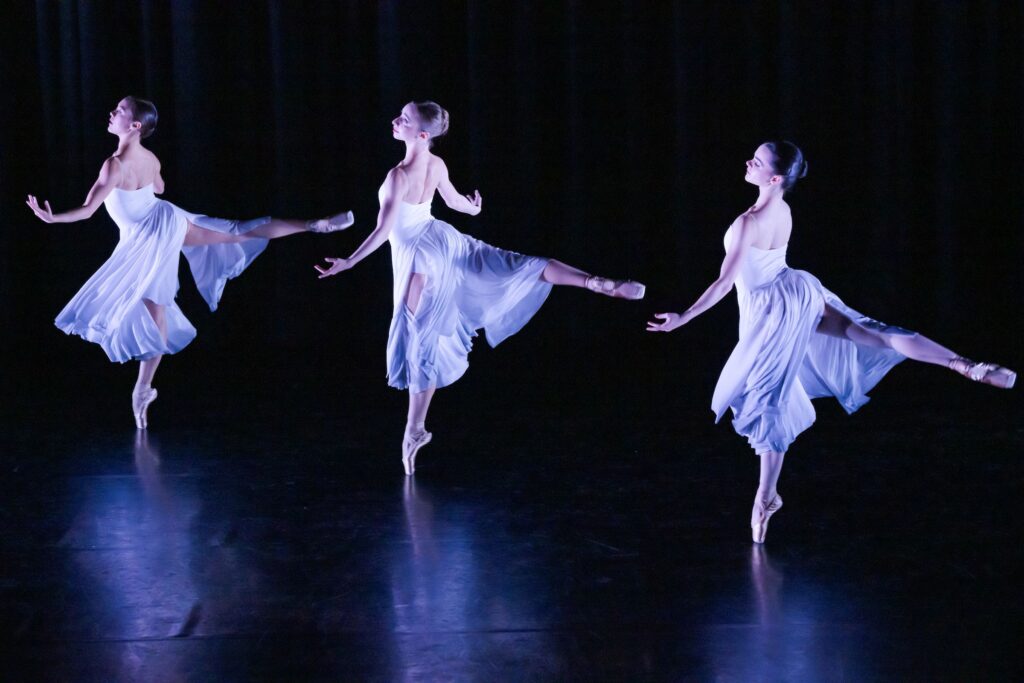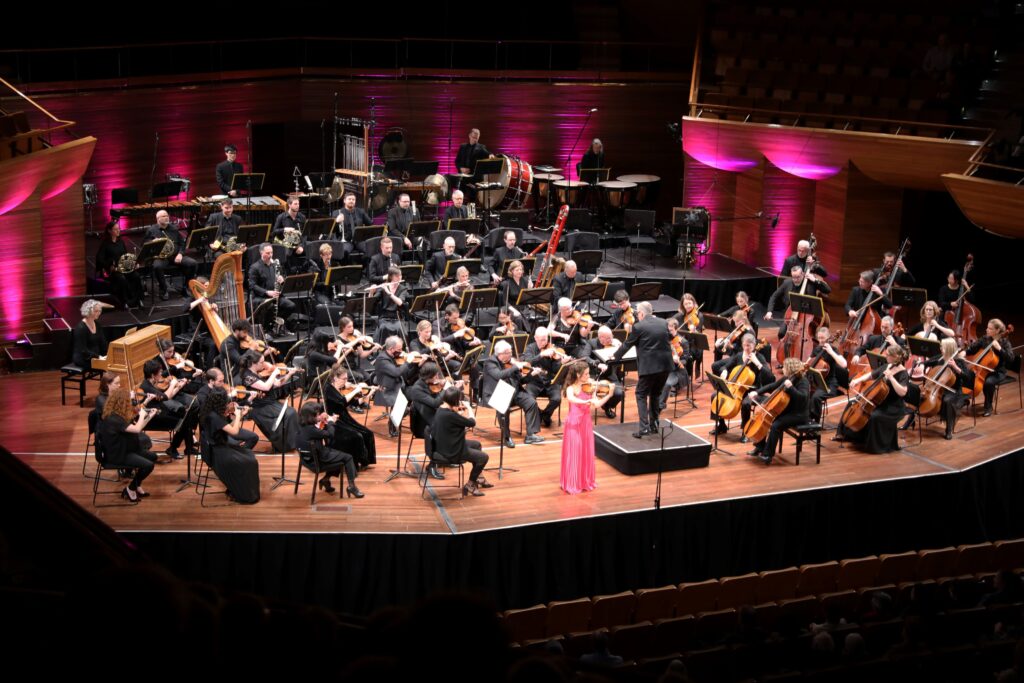Tutus on Tour –
The Royal New Zealand Ballet presents Tutus On Tour 2025.
Photo credits: Stephen A’Court.

Limerence (Anneliese Macdonald) – Above, Principal Joshua Guillemot-Rodgerson and Soloist Katherine Minor
Grand Pas Classique – chor. Gsovsky, music Auber
Limerence – Anneliese Macdonald, music Schubert piano trios
Coppelia – Saint-Léon, music Delibes
The Way Alone – Stephen Baynes, music Tchaikovsky piano & chamber works
Royal New Zealand Ballet
Te Raukura, Kapiti
21 February 2025
If you live in Denmark and want to see ballet you go to Copenhagen, the company does not come to you. It’s the same in most countries but Tutus on Tour sees Royal New Zealand Ballet, reputedly the most ready-to-tour of all world ballet companies, taking a programme of shorter works to many smaller centres around the country. In that, they are retracing part of the original itineraries in 1950s, when the founding director Poul Gnatt took his dancers out on the highways and byways, picked up hitch-hikers, chatted with the locals, employed dancers who doubled as truck drivers, lighting riggers, wardrobe and stage hands, so they could show the country that ballet is not an esoteric art that fell out of the courts of Europe, but a loved art form that found and kept its place in the hearts of many New Zealanders. Ballet belongs here as much as anywhere — it inspires, amuses and consoles, as dancers use their exquisitely trained bodies to move to music, so that we in turn might be moved. As indeed we were.
The venue Te Raukura, in Kapiti College grounds, is in itself impressive — drama facilities for students by day, and a fine and accessible theatre by night, with a smaller box theatre in the complex named for Jon Trimmer, so it feels like family already.
Nga mihi to a refreshing new tone in the programme notes, connecting present with past, and details of the music recordings are appreciated. We sense a mindful quality emanating from the overall performance – the opposite of the old bravura and virtuosity for its own sake, that interrupts with applause and cheers from audience as they go. Not so with Ty King-Wall I think, the company’s new artistic director who is bringing a sense of measure and proportion to the programme. In four works there is contrast of old and new, but each of them offers a mood we recognise, from celebratory to introspective to serene. The dancers are not performing at us, but dancing for us, with us.
The opening Grand Pas Classique, to music by Daniel-Francois Auber, is a pas de deux that sparkles with Parisian glamour, (and it’s a captivating image to read that Poul Gnatt might have watched this work from the wings when it was premiered in 1949 by Ballets des Champs Elysées where he was a dancer at the time).
Elegantly danced by Jemma Scott and Zacharie Dunn, their technique is clean and grows in assurance, unfolding like unwrapping a gift, and then, six minutes in, the music dies. It’s a moment of held breath for everyone. Will the curtain come down, will the plane pull up and abort the landing, who’s in charge, pilot or control tower? The dancers dance on in the silence, like good nurses they know not to panic, they have the rhythm and tempi by heart anyway, but this is like having to drive blind, in the sudden dissection of cause and effect between dance and music. The pair arrive at a silent cadence then exit the stage, as though they were always meant to do so. Stage Manager checks in and assures us the glitch will soon be fixed, which it is … the performance continues, and then, pull up, pull up, it all happens again. That the dancers continue to keep their calm, holding balances while masking any uncertainty, is testament to the tight team that is running this show. It’s not when things go wrong but what you do next that counts, and of course planes will land safely in Wellington. Again the couple continues, more defiantly now, to a triumphant finish. They are in the palm of our hands and the applause lets them know that.
Limerence, a new word for me, meaning a strong attraction to someone yet with haunting thoughts of another from the past, proves the perfect title for this striking choreography by Anneliese Macdonald. To Schubert piano trios, it’s an enigmatic but compelling piece in which the magnetic central role is danced by Joshua Guillemot-Rodgerson. The woman he is with is aware of the distractions, though there’s no specific narrative that cuts into the drama of a man and his thoughts, his present and his past, memories, ghosts. “Let it go” she would say if asked, but she isn’t asked. There’s a cast of four on stage but with a layering that hints they are perhaps not all in the same place at the same time. Jackets on, jackets off — what’s public, what’s private, what’s a dream, what’s for real? The two women — Ana Gallardo Lobaina and Katherine Minor are not identical in offstage appearance, yet by some curious alchemy and inspired lighting they seem to slowly become each other as the work unfolds. It is focused, introspective, melancholic — beyond words maybe, but with imagery that shows us what’s inside a head and heart. It’s a tight and striking little masterwork from a gifted choreographer, and one imagines it would also translate into a fine cameo film.
The Wedding pas de deux from Coppélia, to Delibes. A happy bridal couple are very well cast – Catarina Estèvez-Collins is splendidly secure in the very considerable technical demands, and Dane Hood dances with unbounded joy. They share real rapport and invest their dance with enthusiasm and sassy style. You can believe the father of the bride spent $10,000 on the best champagne for these wedding festivities.
After the interval, a longer and larger group work – The Way Alone, choreographed by Stephen Baynes, originally for Hong Kong Ballet in 2008, is here developed for Royal New Zealand Ballet, and will be seen again in a further season soon.
 The Way Alone – Stephen Baynes
The Way Alone – Stephen Baynes
Tchaikovsky is probably the best known composer for full length and large scale ballets in the world repertoire, but here Baynes has chosen from his lesser known choral and chamber works with sacred or spiritual connotations. Each section segues from lyrical to meditative, and serene atmospheres. There are solo moments, as well as small and larger group passages well designed for the theme that everyone is essentially alone while still a member within a group or community. Rose Xu moves with a beautifully serene quality, and Katherine Minor is notable for the way her torso seems to cause the sequential movement of limbs. An aura of poem or prayer emerges from this beautiful group work which meets the music throughout.
I went by myself to the performance but made new friends. You just have to point out someone’s missed the programmes available in the foyer and fetch one for them … you do that again, and again — for a couple from England who visit family each year and always time that to coincide with an RNZB season, for a local businessman who’s never been to the ballet before, for a little old lady steadying herself in the aisle afterwards “Well that was a lyrical endpiece” I say to her – to which she replies, punching the air, “Nah – I’m really into the contemporary work — that Limerence got to me … so layered and interesting…oo I loved it.” I’m with you, Ma’am.
… so I made five new friends — whose names I don’t know and we’ll never meet again, but we won’t forget our night at the ballet… and they now have programmes to check details of all the music they heard – in the symbiosis of two arts.

